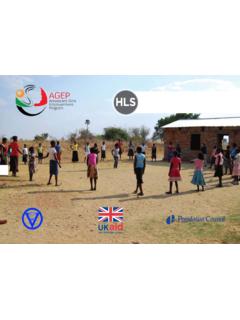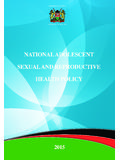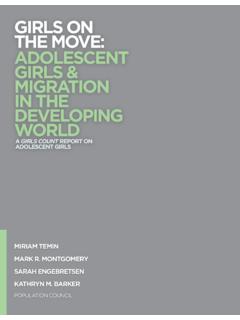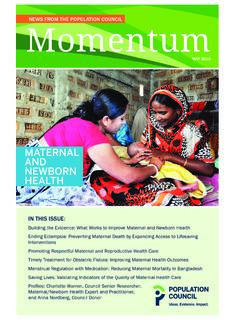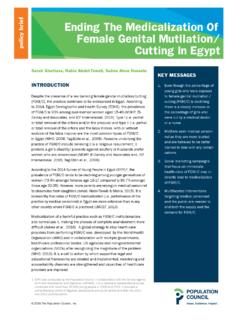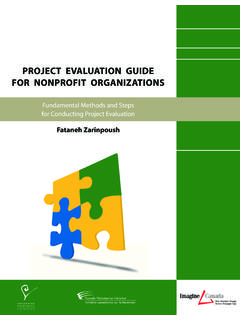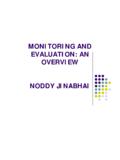Transcription of Training manual on basic monitoring and …
1 Toolkit Training manual ON basic monitoring AND evaluation OF SOCIAL AND BEHAVIOR CHANGE COMMUNICATION HEALTH PROGRAMS Praween K. Agrawal Kumudha Aruldas MARCH 2014 The Population Council confronts critical health and development issues from stopping the spread of HIV to improving reproductive health and ensuring that young people lead full and productive lives. Through biomedical, social science, and public health research in 50 countries, we work with our partners to deliver solutions that lead to more effective policies, programs, and technologies that improve lives around the world. Established in 1952 and headquartered in New York, the Council is a nongovernmental, nonprofit organization governed by an international board of trustees. Population Council Zone 5A, Ground Floor, India Habitat Center Lodi Road, New Delhi 110 003 India Tel: +91-11-24642901/02 Suggested citation: Agrawal, , K. Aruldas & Khan,. 2014. Training manual on basic monitoring and evaluation of Social and Behavior Change Communication Health Programs.
2 New Delhi: Population Council. Table of Contents List of abbreviations ..04 ..05 Module 1: basics of social and behavior change Module 2: Introduction to monitoring and Module 3: Developing logical framework analysis for a SBCC 22 Module 4: monitoring of SBCC program at district and block Module 5: Research designs for evaluating SBCC Module 6: Role of qualitative methods in evaluating SBCC Module 7: Developing terms of reference for evaluating SBCC Glossary: ..70 iii List of Tables and Figures Tables Example of log frame for SBCC .. 24 Location hunt form .. 28 Checklist for quality assessment of group meeting conducted by CHW .. 29 Exit Interview form .. 30 SBCC activity report .. 32 Figures Health Belief Model .. 08 Socio- Ecological model for change .. 09 Theory of reasoned action/planned behavior .. 10 Three key strategies of social behavior change communication .. 12 iv List of Abbreviations ASHA Accredited Social Health Activist BCC Behavior Change Communication FHI 360 Family Health International FP Family Planning IEC Information, Education, and Communication IHBP Improving Healthy Behaviors Program IPC Interpersonal Communication IUCD Intra-uterine Contraceptive Device M&E monitoring and evaluation NGO Non-governmental organization NIHFW National Institute of Health and Family Welfare NRHM National Rural Health Mission SBCC Social and Behavior Change Communication SHRC State Health Resource Center SIHFW State Institute of Health and Family Welfare TOR Terms of reference TV Television USAID United States Agency for International Development 1 Introduction Social and behavior change communication (SBCC)
3 Interventions are increasingly seen as the key interventions for addressing social and cultural barriers and achieving goals laid out for health programs. States have the responsibility to plan and implement SBCC activities. Focus on mass media, community mobilization and interpersonal communication is increasingly gaining importance as SBCC interventions in the State Project Implementation Plans (PIPs) with increasing resource allocation to achieve the objectives. Often these interventions are not evidence based and especially for mass media it is mistakenly assumed that the interventions will benefit all equally. Though monitoring and evaluation (M&E) of overall National Rural Health Mission (NRHM) is considered important, M&E of SBCC interventions is limited. Lack of trained and skilled human resources for M&E has been a limitation in general. This demands a serious effort to build capacity of M&E personnel to monitor and evaluate performance of SBCC interventions in terms of reach and effectiveness among intended audiences.
4 Improving Healthy Behaviors Program (IHBP) of FHI360, funded by USAID, aims to provide technical assistance to strengthen capacities to monitor and evaluate SBCC intervention for maternal health, family planning, tuberculosis and HIV/AIDS at of public program managers at na tional, state and district level. The project is coordinating with National Institute of Health and Family Welfare (NIHFW), and the State Institute of Health and Family Welfare (SIHFW) to build the trainers capabilities within the state in this area. The Population Council will train a cadre of master trainers on M&E of SBCC activities at the national and state level who would further build capacity of human resources responsible for M&E of SBCC activities within the state at the district level. To address the capacity building initiative in M&E of SBCC intervention, a ' Training manual on basic monitoring and evaluation of Social and Behavior Change Communication Health Programs' is prepared.
5 The key personnel trained in this initiative will include master trainers, state program M&E officers and managers, district level officials and supervisors whose main job is to monitor SBCC interventions in their geographical area of work. The extent of involvement of these personnel in planning and executing the M&E activities vary. Therefore, the depth of Training content covered will vary depending on the level of function of the officials and supervisors that are trained. The Training manual is comprehensive to include various aspects of M&E. It includes the following seven modules: Module 1: basics of SBCC: The learning objective of module-1 is to differentiate between IEC and SBCC; orient participants on how theories of behavior change have evolved and the process used in designing a SBCC intervention. Module 2: Introduction to monitoring and evaluation : The module-2 will enable participants to learn what is monitoring and evaluation and distinguishes between process, output and outcome indicators specific to social and behavior change.
6 Module 3: Developing logical framework analysis for a SBCC program: From module-3, the participants will learn to develop a logical framework matrix that will guide M&E of SBCC interventions. They will also learn to develop indicators with respective to the goal, objectives and activities of the SBCC program. Module 4: monitoring of SBCC program at district and block level: Using module-4, the participant will understand how to monitoring quality of SBCC activities implemented and design district and block 2 specific feedback mechanisms. Module 5: Research designs for evaluating SBCC program: The objective of module-5 is to orient the participants to various evaluation approaches and frameworks, increase capacity to design appropriate evaluation methodology and orient to overcoming barriers in effective evaluation . Module 6: Role of qualitative methods in evaluating SBCC program: The objective of module-6 is to orient participants on importance of qualitative approaches for monitoring and evaluation of SBCC interventions.
7 They will learn about various qualitative methods. Module 7: Developing terms of reference for evaluating SBCC program: The module-7 is mainly meant for the state officials who will learn how to develop Terms of Reference for contracting agencies for evaluation of SBCC programs. Overall, the Training manual is organized around concepts of M&E for SBCC interventions with st rengths and weakness of approaches and recommendations wherever applicable and necessary. The manual aims to strengthen efforts of SBCC interventions by building capacity to effectively monitor and evaluate intervention against desired outcomes and provide learning for SBCC strategies. The guiding principles in development of this manual are the various roles played by officials at various levels within the state; the block supervisors are responsible for supervising implementation of day to day activities and providing feedback during weekly and monthly meetings; district M&E officers are responsible for data collation to assess the progress of interventions using output indicators and provide feedback and the state level officials in addition to monitoring are also responsible for evaluation of the programs.
8 The Training methodology and the possible exercises that could be used to facilitate learning are mentioned in the Facilitator s Guide that accompanies this manual . 3 Module 1 basics OF SOCIAL AND BEHAVIOR CHANGE COMMUNICATION What is the difference between IEC and SBCC? Information, Education and Communication (IEC) is a process of providing information and education to individuals and communities to promote healthy behaviors that are appropr iate to their context. It is believed that having correct knowledge will lead to adoption of healthy behaviors but the experience of IEC programs shows that knowledge is not a necessary and sufficient condition for behavior change. There are lot of examples which show that giving correct knowledge has not always led to adoption of healthy behaviors. This is because adoption of a behavior is also influenced by the external environment; the local context, family and community at large, in which the individual is placed.
9 Social and Behavior Change Communication (SBCC) has evolved from earlier models of IEC and is an evidence-based, consultative process of addressing knowledge, attitudes, and practices through identifying, analyzing, and segmenting audiences and participants in programs and by providing them with relevant information and motivation through well-defined strategies, using an appropriate mix of interpersonal, group and mass media channels, including participatory methods (Neill McKee, 2002). SBCC aims to affect changes in knowledge, attitudes, and practices and is a more comprehensive approach than IEC. SBCC involves analyzing personal, societal, and environmental factors for sustainable change and uses strategies that influence the physical, socio -economic, and cultural environment to facilitate healthy norms and choices and remove barriers to them. Learning Objectives To know the difference between Information Education and Communication and Social and Behavior Change Communication To have an overview of various theories of behavior change To understand the Socio-Ecological model for change 4 Theories of behavior change Health Belief Model The Health Belief Model is a psychological model of behavior change.
10 It is based on the individuals perception of acquiring the disease and its severity ; analysis of benefits in taking action to reduce the barriers in adopting healthy behavior and relative cost benefit of adopting a healthy behaviour (Figure 1). FIGURE : THE HEALTH BELIEF MODEL Source: Adapted from Stretcher, V., & Rosenstock, (1997). The Health Belief Model. In Glanz K., Lewis, , & Rimer BV. K., (Eds). Health Behavior and health Education: Theory, Research and Practice. San Francisco: Jossey -Bass. Modifying factor Age Gender Knowledge Socio-economic status Previous experience Previous experience Individual's perceived: susceptibility severity threat Individual's perceived: benefit of changing behavior Change in behavior 5 Theory of Reasoned Action/Planned Behavior The Theory of Reasoned Action, modified as Theory of Planned Behavior, is a socio -cultural model for behavior change. In this, the primary determinant of behavior is the individual s intention to perform it which depends on their attitude towards performing the behavior and the individual s perception of the social (or normative) pressure exerted upon them to adopt or not to adopt the behavior (Figure 2).
